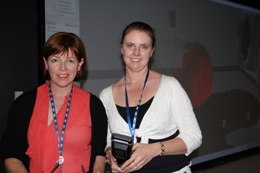13 April 2012
 A new virtual reality cancer treatment training facility at the University of South Australia is allowing student radiation therapists to learn the best possible treatment and care of cancer patients.
A new virtual reality cancer treatment training facility at the University of South Australia is allowing student radiation therapists to learn the best possible treatment and care of cancer patients.
The Virtual Environment Radiotherapy Training (VERT) technology was installed at UniSA’s City East Campus late last year and has been used by students in the Bachelor of Medical Radiation Science (Radiation Therapy) program from the start of 2012.
Stream Coordinator and Lecturer in Radiation Therapy Eileen Giles says many of the students using VERT have been totally engaged and amazed by how much they can learn from the new technology.
“There’s certainly been a few ‘ah-ha’ moments where the penny’s dropped,” Ms Giles says.
“Radiation is very conceptual and some concepts are difficult to teach when you’re talking about radiation that can’t be seen. VERT allows us to look at the internal structures of the patient and to see the radiation dose that we’re delivering and where that dose goes in relation to the areas we want to treat and the critical structures of the patient that we want to spare, such as the spinal cord and vital organs.”
UniSA was one of six Australian universities which secured funding worth $850,000 over five years from the Department of Health and Ageing to implement VERT.
UniSA will hold an official launch for VERT next Tuesday April 17, with Pro Vice Chancellor: Health Sciences, Professor Allan Evans, hosting invited guests for a demonstration of the technology.
VERT provides a three dimensional stereoscopic display of a radiation treatment room, allowing the demonstration of treatment techniques and providing a better understanding of treatment concepts for students.
Ms Giles says students are immersed into the treatment room with the aid of real controls and three-dimensional glasses.
“They can treat a virtual patient and examine the delivery of radiation dose within that patient, seeing past the skin to identify internal structures and anatomical relationships,” Ms Giles says.
“This technology allows the development of clinical skills in a simulated and safe environment and provides the potential to engage clinicians and other professionals in multi-disciplinary education and training.”
Ms Giles says VERT will help UniSA graduates be best prepared for clinical work and will have flow-on benefits in terms of managing workforce.
“Being able to prepare students in this way, where they know how to operate the equipment safely, that reduces the burden on the clinical sites from the get-go,” she says.
UniSA has employed clinical co-ordinator Rachaelle Dantu on secondment from the Royal Adelaide Hospital to develop the authentic resources, which includes program upgrades and additions of specific modules such as paediatrics and physics.
Other universities involved in the joint funding submission were the The University of Sydney, The University of Newcastle, Queensland University of Technology, Monash University and RMIT University.
Two aims of the collaborative submission were to form a VERT academic community of practice where competency development and learning resources are shared, and to establish and promote collaborative partnerships with clinical departments and to utilise VERT for research, education and quality assurance programs for the wider professional community.
Media contact
- Kelly Stone office (08) 8302 0963 mobile 0417 861 832 email kelly.stone@unisa.edu.au



